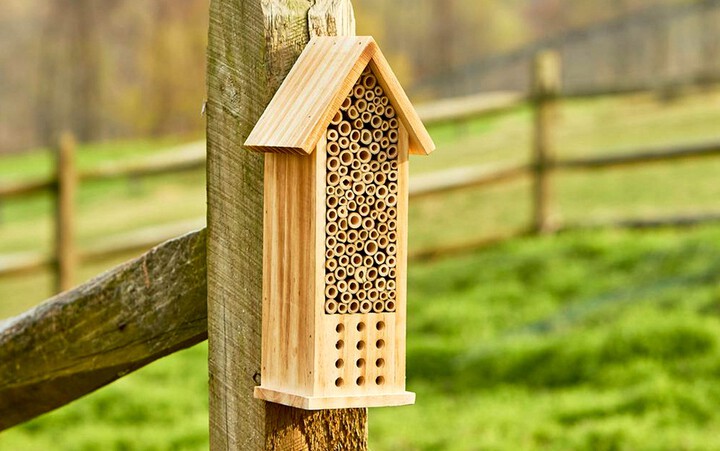Hanging a native bee house outdoors will encourage bees to visit your yard and pollinate your fruit trees.
Maybe you've never thought about deliberately attracting bees to your yard, but here's the thing: Native bees like leafcutter and mason bees don't sting. They help your greenspace flourish, especially if you have fruit trees or spring berry plants, and they boost the local bee population. Getting them to visit is as simple as hanging a bee house outdoors in the sun. The right structure for native bees look sort of like a birdhouse, or even a honeycomb, with lots of small tubes packed tightly together. The bees lay their eggs in the tubes and will continue to return all season long.
In order to keep the bees happy, you'll need to do a little routine maintenance to keep the house clean. Otherwise, hosting mason bees is almost completely hands-off. Follow our simple steps for cleaning a bee house the right way.

How to Clean a Bee House
Mason bees are solitary and don’t produce honey, so they don’t form colonies or have hives to defend. That’s why they won't sting you as they're flying around, even if you're near their house; in place of hives, the bees seek out individual holes or tubes to nest in. Mason bees are native to most parts of the U.S., with the exception of the southernmost states like Florida, Georgia, and Alabama, where it's just too hot for them to thrive. Still, those states also have native, solitary species like leafcutter bees that could benefit from a bee house in your yard.
After laying their eggs, mason bees use mud to seal off their nesting tubes to protect their eggs over the winter. In the spring, as the new bees emerge from their cocoons, they'll tunnel out through the mud and go to work in your garden.

Getting a bee house completely clean is tricky because of all the nooks and crannies. Instead of trying to deep-clean the entire house, you can make the task a lot easier by buying a bee house with bamboo, paper, or cardboard tubes that can be replaced each year. Some models of bee houses will come apart so you can easily remove and toss the tubes once the new generation of bees emerges in spring. That'll drastically reduce the cleaning work, and instead of trying to clean each tube, you can just replace them and rinse away any extra mud or dirt on the inside of the house.
If you can't replace the tubes in your house, it’s best to only use it for one year and start with a new one in spring. But you don't want to toss out any bees! To make sure they're all out, seal the house in a cardboard box and set it outside in the sun. Cut a small hole in the box for any hatching bees to leave through; they’ll see the light and exit out the hole, but won’t reenter the box or the house. Then, after a few days, you can toss the old house without harming any live bees or cocoons.
Another alternative is to let someone else handle the dirty work. Companies like Rent Mason Bees offer nesting blocks you can rent. Then you can return them at the end of the summer to be cleaned.
When to Clean a Mason Bee House
Timing is everything when you’re cleaning or replacing your bee house; too early, and you could toss mason bee cocoons that haven't emerged yet; too late, and you could toss new eggs. Once the temperatures reach the mid-50s again, the new generation of bees will start leaving the nests and flying around your yard. You'll know they're hard at work once you see exit holes in the mud sealing the ends of the tubes. At this point, you can replace the inner tubes with clean ones or hang up your new house so the bees can lay eggs in them at the end of their six- to eight-week pollinating season.
If you don't see bees leaving the tubes in spring, it might've been too cold over the winter for the bees to survive. If you can, it's best to move the house into a garage or garden shed for the winter when the temperature starts dropping to protect the developing bees from the worst of the chill. Then, you can hang it back outside in spring in a sunny spot when it's time for them to leave the house.
Solitary bees are easy to host in your yard as long as you're willing to do a little maintenance once a year. They’ll reward your efforts by pollinating your plants and boosting the local bee population.